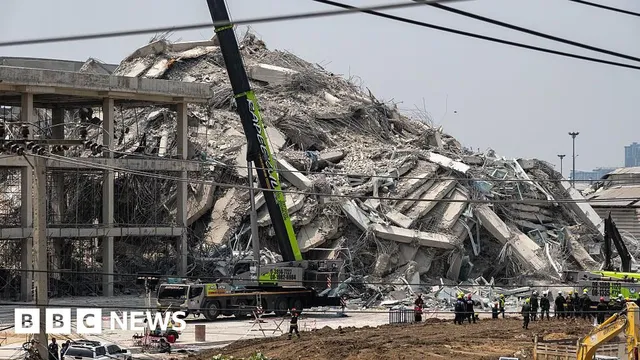
Seventeen face charges for negligence in Bangkok skyscraper collapse
2025-05-16 04:09- Seventeen individuals, including a prominent construction magnate, are facing criminal charges related to a deadly building collapse.
- The incident took place during a massive earthquake in Myanmar, which led to severe structural failure in the under-construction tower.
- Authorities are probing into the negligence and potential regulatory failures in the Thai construction industry following the disaster.
Express your sentiment!
Insights
In Thailand, on March 28, 2025, a devastating earthquake with a magnitude of 7.7 struck Myanmar, causing significant tremors felt in Bangkok. One of the critical consequences was the collapse of a 30-storey tower under construction meant to serve as the new State Audit Office. This incident resulted in the tragic loss of 92 lives, with a number of individuals still reported missing. Subsequently, authorities began investigating the structure's integrity and whether the builders had adhered to safety standards that could have prevented this disaster. Following the ongoing investigation, a Criminal Court issued 17 arrest warrants for individuals implicated in the project's design, construction, and supervision. Among those charged was Premchai Karnasuta, the president of Italian-Thai Development PLC, who turned himself in alongside others accused of professional negligence causing death. Investigators highlighted serious structural flaws, particularly in the core lift shaft, and cited substandard concrete and steel. Allegations of irregular documentation related to the project have surfaced, raising questions about corruption and oversight in the construction sector in Thailand. Following the earthquake, efforts to rescue victims and recover remains involved drones and excavators, although the official search was halted after confirming the fatalities. The wider impact of the earthquake in Myanmar was severe, resulting in over 3,700 deaths and significant devastation to Mandalay and Naypyitaw.
Contexts
The Thai construction industry has been undergoing significant scrutiny in recent years concerning its safety standards. With the rapid growth of infrastructure development and urbanization, the demand for robust safety protocols has intensified. Construction sites have become hotspots for accidents, which have raised concerns about worker safety and regulatory compliance. Despite the government's efforts to implement stringent safety regulations, the reality on construction sites often reflects gaps in adherence to these standards, leading to injuries and fatalities. Therefore, understanding the factors influencing safety practices in the Thai construction industry is essential for fostering a culture of safety and accountability among stakeholders. One of the primary issues plaguing the industry is the lack of comprehensive training for workers. Many employees enter the workforce without adequate knowledge of safety measures, putting themselves and their colleagues at risk. Furthermore, ongoing training programs are sporadically implemented, and there is often insufficient emphasis placed on worker empowerment regarding safety issues. Improved training and educated supervision on construction sites can positively affect safety compliance. As organizations in Thailand's construction sector recognize the importance of such initiatives, one potential method to enhance safety awareness could be mandatory safety training workshops that are regularly updated to reflect current best practices. Moreover, the enforcement of existing regulations poses another critical challenge. While Thai law stipulates specific safety standards, enforcement is often inconsistent. Local authorities are sometimes ill-equipped, either due to a lack of resources or prioritization of other pressing issues, thus failing to monitor compliance effectively. Without robust enforcement mechanisms, unsafe practices can continue unabated. Collaboration between the government and industry stakeholders, including regular audits and inspections, can help to ensure that regulations are rigorously applied. Moreover, employing technology such as digital reporting systems could lead to better tracking of violations and more immediate corrective measures. In conclusion, the construction industry's safety standards in Thailand need to evolve to address the complexities and challenges faced. This evolution necessitates a multi-faceted approach involving improved training, stricter enforcement of regulations, and fostering a culture of safety that prioritizes worker well-being. Stakeholders, including government bodies, construction companies, and labor organizations, must work together to create a safer working environment. Only through collective action can the Thai construction industry mitigate risks and protect the lives of those who contribute to the nation’s infrastructure development.